Natural and Culturo-Historical Region of Kotor: Kotor is a coastal town in the northern part of Montenegro. Kotor is located at the deepest end of the Bay of Kotor (Boka Kotorska). The Bay of Kotor is the deepest natural fjord in the Mediterranean. Kotor is an ancient Mediterranean port. The town was conquered several times. From the 10th century until the end of the 12th century, Kotor was part of the Byzantine Empire. Kotor was besieged by the Ottoman Empire in 1538 and 1657. Amongst its successive occupiers were Austria, Italy and Hungary. The medieval town of Kotor is surrounded by an impressive defensive wall, built by the Republic of Venice. The wall stretches from the sea along the hill slopes of the Mountain of San Giovanni (St. John) up to the fortress of San Giovanni on the top. The Sea Gate is the main entrance into the historic town of Kotor. The fortress of San Giovanni, the Castle of St. John, is located on top of the Mountain of San Giovanni and towers high above Kotor and its Bay, the Boka Kotorska. Climbing up the 1350 steps to the fortress of San Giovanni will be rewarded with the most breathtaking views of Kotor and the Bay of Kotor. The historic centre of Kotor is home to a number of imposing monuments. The largest and most impressive of these monuments is the Cathedral of Saint Tryphon. Some other monuments in Kotor are the Serbian Orthodox St. Nicolas Church, the former Church of St. Michael and the small Serbian-Orthodox St. Lucas Church. The Natural and Culturo-Historical Region of Kotor gained the status as a UNESCO World Heritage in 1979.
www.werelderfgoedfotos.nl © Copyright World Heritage Photos
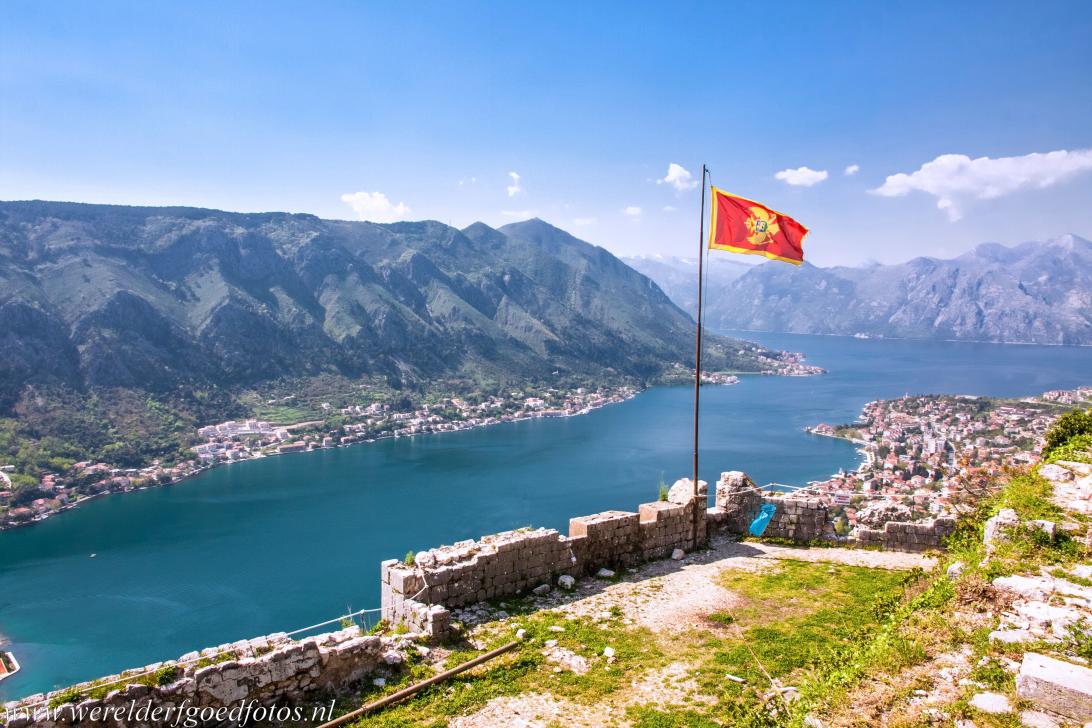
Kotor and the Bay of Kotor: The flag of Montenegro stands atop the the Fortress San Giovanni, the Fortress of St. John. The Bay of Kotor is also known as Boka Kotorska, or just Boka. The bay is surrounded by medieval towns such as Kotor and Perast. The Bay of Kotor is a winding side arm of the Adriatic Sea. The Natural and Culturo-Historical Region of Kotor was inscribed on the UNESCO World Heritage List in 1979.

Kotor and the Bay of Kotor: The flag of Montenegro stands atop the the Fortress San Giovanni, the Fortress of St. John. The Bay of Kotor is also known as Boka Kotorska, or just Boka. The bay is surrounded by medieval towns such as Kotor and Perast. The Bay of Kotor is a winding side arm of the Adriatic Sea. The Natural and Culturo-Historical Region of Kotor was inscribed on the UNESCO World Heritage List in 1979.
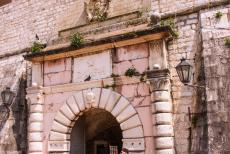
Natural and Culturo-Historical Region of Kotor: The 16th century Sea Gate is the main entrance into the historic town of Kotor. Above the gate is a plaque to mark the liberation from the Nazi's in 1944, on the plaque is written 'Theirs we don't want, ours we don't give', a political slogan of former Yugoslavia, the slogan is often attributed to Josip Broz, commonly known as Tito. The Sea Gate is one of the three city gates of the medieval town of Kotor.

Natural and Culturo-Historical Region of Kotor: The Clock Tower is a symbol of Kotor. The tower is located in the central square in the historic center of Kotor. The Clock Tower was built in 1602 and has Baroque and Gothic style elements. The tower is considerable leaning towards the west caused by the earthquake in 1676. The tower stands opposite the Sea Gate. Although Kotor is a small town, it has numerous churches within its fortifications.
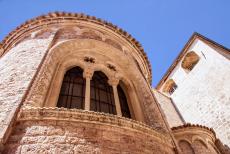
Natural and Culturo-Historical Region of Kotor: The Romanesque Cathedral of St. Tryphon is one of the two Roman Catholic churches in Montenegro. The cathedral was consecrated in 1166 and dedicated to Saint Tryphon, the patron saint of Kotor, the cathedral houses his relics. The façade and the bell towers of the cathedral were destroyed by an earthquake in 1667 and rebuilt in the Baroque style. The cathedral was built on the site of a much earlier church from 809.

Natural and Culturo-Historical Region of Kotor: The towers of the Serbian Orthodox St. Nicholas Church, the Sveti Nikola. The St. Nicholas Church was built in the pseudo-Byzantine style in the period 1902-1907, the church houses a collection of silver, icons, and an iconostasis, a wall of icons and religious paintings, separating the nave from the sanctuary. Above the entrance is a mosaic, depicting St. Nicholas.
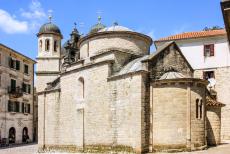
Natural and Culturo-Historical Region of Kotor: The St. Nicholas church, the Sveti Nikola. The St. Nicholas Church is the largest Serbian Orthodox church in Kotor. The gold crosses adorning its domes and towers were a gift from Russia. There are also several small churches in the historic town of Kotor, among them are the Serbian-orthodox St. Lucas Church, the Sveti Luka, and the St. Clara Church, the Sveta Klara.
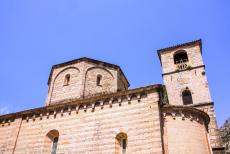
Natural and Culturo-Historical Region of Kotor: The St. Ozana church, the Sveta Ozana, also the Church of St. Mary of the River, was built in 1221, The dome over the central nave is octagonal in shape. The St. Ozana Church stands on the site of a much earlier church, the baptismal font of this 6th century church was discovered after the 1979 earthquake. Just behind the church lies a 14th century pharmacy, probably the oldest pharmacy of the Balkans.
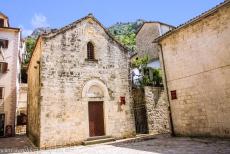
Natural and Culturo-Historical Region of Kotor: The former Church of St. Michael, Sveti Mihailo. The Church of St. Michael was constructed at the end of the 14th century, the church was part of a Benedictine monastery. The interior of the church is decorated with frescoes. The frescoes on the northern wall are reasonably well preserved. Today, the former church houses the Kotor City Lapidarium, a collection of stone fragments from ancient monuments of Kotor.
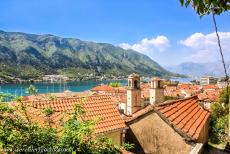
Natural and Culturo-Historical Region of Kotor: The two towers of the Cathedral of St.Tryphon rises above Kotor. The towers were built in different styles and are also different in height. The interior of the cathedral is adorned with 14th century frescoes. The Romanesque cathedral was damaged by an earthquake in 1979, the restoration and renovation was completed in 1987. The remains of an earlier church from the 9th century were uncovered during the restoration.
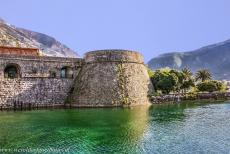
Natural and Culturo-Historical Region of Kotor: The Kampana Tower is a bastion of the fortified town walls of Kotor. The medieval Port of Kotor is surrounded by fortifications, built during the Venetian Period, from the 8th until the 18th century. The historic town of Kotor is located on the banks of the Bay of Kotor. The Natural and Culturo-Historical Region of Kotor gained the status as a UNESCO World Heritage in 1979.
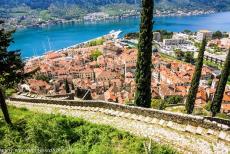
Natural and Culturo-Historical Region of Kotor: The long staircase leading to the Fortress of San Giovanni, the Fortress of St. John. The fortress is situated on top of St. John Hill and overlooking Kotor and its bay. The fortress contains traces of Illyrian civilisation (about the 5th century BC). To reach the Fortress of St. John, you must climb about 1400 steps. The fortress can be reached in about one hour, the climb is steep and the steps on the staircase are uneven.
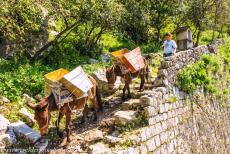
Natural and Culturo-Historical Region of Kotor: Two donkeys carrying up restoration materials to the old Fortress of San Giovanni, the Fortress of St. John. Kotor and its surrounding area were severely damaged by a number of earthquakes. The 1979 Montenegro earthquake lasted only ten seconds, but Kotor and its surrounding fortifications were heavily damaged. At the time of our visit, the traces of the earthquake were still visible.
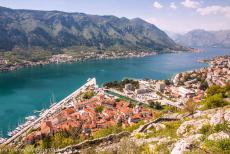
Kotor and the Bay of Kotor seen from the Fortress San Giovanni, the Fortress of St. John. The fortress is situated at an altitude of 280 meters above the Bay of Kotor. The St. George's Island and the artificial Island of Our Lady of the Rocks, Gospa od Škrpjela, are situated off the coast of the town of Perast in the Bay of Kotor. The ancient fortified town of Kotor is situated on a small peninsula, the historic centre of the town is triangular in shape.
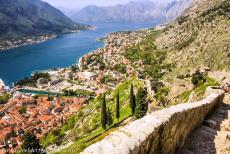
Natural and Culturo-Historical Region of Kotor: The Church of Our Lady of Health is situated half way up the fortress walls of Kotor, the church can only be reached on foot. The church was built in 1518, the remains of a 6th century church were found under the church. In 1572, it became a votive church following several plague epidemics, the church became also a popular pilgrimage destination. The bell tower is 18 metres high and contains three bells.
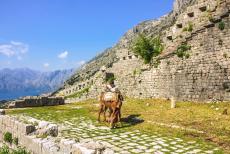
Natural and Culturo-Historical Region of Kotor: A donkey on the fortified walls of Kotor. The walls are approx. four km long. The fortifications dates back to medieval times. In the past, the fortifications were severely damaged by multiple earthquakes. Despite restorarion efforts, the traces of these earthquakes remain visible. Efforts to preserve and protect the fortifications are still ongoing. The fortifications of Kotor are an important part of the UNESCO World Heritage.
